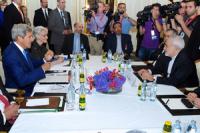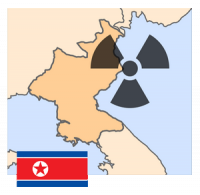-
Epigenetic Tool for Detecting Exposure to WMD
With a $38.8 million award from DARPA, researchers are working on developing a field-deployable, point-of-care device that will determine in 30 minutes or less whether a person has been exposed to weapons of mass destruction or their precursors. The device will be capable of detecting the health effects of a number of substances associated with weapons of mass destruction, including biological agents, radiation, chemicals and explosives. The detection devices will scan potential exposure victims for epigenetic changes, that is, chemical modifications that affect genes, altering their expression while leaving the genetic code intact.
-
-
Trump Administration Has Gutted Programs Aimed at Detecting Weapons of Mass Destruction
The Trump administration has quietly dismantled or cut back multiple programs that were created after the Sept. 11, 2001, attacks to help detect and prevent terrorism involving weapons of mass destruction, a Times investigation has found. The retreat has taken place over the last two years at the Department of Homeland Security, which has primary domestic responsibility for helping authorities identify and block potential chemical, biological, radiological and nuclear threats. A Los Angeles Times investigation found that the changes, not previously reported, were made without rigorous review of potential security vulnerabilities, the Times found, undermining government-wide efforts aimed at countering terrorist attacks involving unconventional weapons, known as weapons of mass destruction.
-
-
Helping first responders deal with dirty bombs
If a radiological dispersal device (RDD), or “dirty bomb,” ever explodes in the United States, emergency crews may be better prepared because researchers have developed a new simulator, which show first responders what an optimal response to an RDD would look like.
-
-
First Responder Radiological Preparedness
A radiological dispersal device (RDD), or “dirty bomb,” detonation in a local jurisdiction will have significant consequences for public safety, responder health and critical infrastructure operations. First responders and emergency managers must quickly assess the hazard, issue protective action recommendations, triage and treat the injured, and secure the scene in support of the individuals, families and businesses in the impacted community.
-
-
New technology to measures WMD threat exposures
Researchers are looking to find molecular signatures in blood that identify previous exposures and time of exposure to materials that could be associated with weapons of mass destruction (including infectious agents, chemicals, and radiation). The epigenome is biology’s record keeper, and Epigenetic technology will provide a new tool in the fight against the proliferation of weapons of mass destruction.
-
-
Iran suspending some nuclear deal commitments

Iranian President Hassan Rouhani announced Wednesday his country will suspend its compliance with prohibitions on stockpiles of enriched uranium and heavy water that were imposed as part of the 2015 international agreement on its nuclear program.
-
-
Detecting radioactive material remotely
Physicists have developed a powerful new method to detect radioactive material. By using an infrared laser beam to induce a phenomenon known as an electron avalanche breakdown near the material, the new technique is able to detect shielded material from a distance. The method improves upon current technologies that require close proximity to the radioactive material.
-
-
Easier access to radioactive waste
At the Hanford Site, waste retrieval has been completed in 17 of 149 large concrete underground single-shell tanks. The tanks were constructed of carbon steel and reinforced concrete between 1943 and 1964 to store a radioactive mix of sludge and saltcake waste from past nuclear processing activities. Hanford is installing new access holes in the tank domes for future retrieval efforts.
-
-
U.S. should reject partial North Korean “concessions”: Experts

The failure to reach an agreement at last week’s Hanoi meeting between President Donald Trump and the North Korean leader Kim Jong-un in Hanoi is but the latest indication that the differences between the United States and North Korea over the latter’s nuclear weapons capability are deep and complex.
-
-
The opening moments of the Chernobyl disaster: New theory
A brand-new theory of the opening moments during the Chernobyl disaster, the most severe nuclear accident in history, based on additional analysis. The new theory suggests the first of the two explosions reported by eyewitnesses was a nuclear and not a steam explosion, as is currently widely thought.
-
-
NRC weakens a critical safety regulation, ignoring Fukushima disaster lessons
The Nuclear Regulatory Commission’s (NRC), in a 3-2 vote, approved a stripped-down version of a rule originally intended to protect U.S. nuclear plants against extreme natural events, such as the massive earthquake and tsunami that triggered meltdowns at the Fukushima Daiichi nuclear plant in Japan in March 2011. The decision will leave U.S. nuclear plants dangerously vulnerable to major floods and earthquakes.
-
-
Developing concepts for escape respirator
DHS S&T announced the Escape Respirator Challenge, a $250,000 prize competition that seeks new concepts for an escape respirator solution. This challenge invites the innovation community to submit relevant, useable, effective, and feasible concepts that protects the user against aerosolized chemical, biological, and radiological (CBR) hazards and provides oxygen.
-
-
Nuclear experts: Archive shows that Iran had “advanced capabilities” to produce nukes
The documents in an archive seized by Israel show that Iran had “more advanced capabilities to make nuclear weapons themselves,” according to a paper being prepared by an anti-proliferation think tank, experts say. Foreign Policy, which saw an early draft of the paper being produced by the Institute for Science and International Security, reported that the information contained in the archive “demonstrates that Washington and the IAEA were constantly underestimating how close Tehran was to a bomb.”
-
-
Israel accuses Iran of having “secret atomic warehouse” near Tehran
Israeli Prime Minister Benjamin Netanyahu has accused Iran of having a secret atomic warehouse near Tehran in a UN speech that was dismissed as false by Iranian officials. Addressing the United Nations General Assembly on 27 September, Netanyahu displayed an aerial photograph of the Iranian capital with a red arrow pointing to what he said was an undisclosed warehouse holding nuclear-related material. He contended that the discovery shows Iran is still seeking to develop nuclear weapons, despite its 2015 agreement with world powers to curb its nuclear program in exchange for the lifting of global economic sanctions.
-
-
Scavenger hunt for simulated nuclear materials
Competing in a fictitious high-stakes scenario, a group of scientists at the Department of Energy’s Lawrence Berkeley National Laboratory (Berkeley Lab) bested two dozen other teams in a months-long, data-driven scavenger hunt for simulated radioactive materials in a virtual urban environment. The competition platform was also built and managed by Lab researchers.
-
- All
- Regional
- Water
- Biometrics
- Borders/Immig
- Business
- Cybersecurity
- Detection
- Disasters
- Government
- Infrastructure
- International
- Public health
- Public Safety
- Communication interoperabillity
- Emergency services
- Emergency medical services
- Fire
- First response
- IEDs
- Law Enforcement
- Law Enforcement Technology
- Military technology
- Nonlethal weapons
- Nuclear weapons
- Personal protection equipment
- Police
- Notification /alert systems
- Situational awareness
- Weapons systems
- Sci-Tech
- Sector Reports
- Surveillance
- Transportation
Advertising & Marketing: advertise@newswirepubs.com
Editorial: editor@newswirepubs.com
General: info@newswirepubs.com
2010-2011 © News Wire Publications, LLC News Wire Publications, LLC
220 Old Country Road | Suite 200 | Mineola | New York | 11501
Permissions and Policies
Editorial: editor@newswirepubs.com
General: info@newswirepubs.com
2010-2011 © News Wire Publications, LLC News Wire Publications, LLC
220 Old Country Road | Suite 200 | Mineola | New York | 11501
Permissions and Policies
